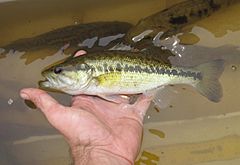Choctaw bass facts for kids
Quick facts for kids Choctaw bass |
|
|---|---|
 |
|
| Conservation status | |
|
Not evaluated (IUCN 3.1)
|
|
| Scientific classification | |
| Kingdom: | |
| Phylum: | |
| Class: | |
| Order: | |
| Family: | |
| Genus: | |
| Species: |
M. sp. cf. punctulatus
|
| Binomial name | |
| Micropterus sp. cf. punctulatus Tringali, Barthel, Seyoum & Knight, 2015
|
|
The Choctaw bass (Micropterus sp. cf. punctulatus) is a type of black bass. It's a newly discovered fish species. You can find it in the rivers of the upper panhandle of Florida.
Contents
How the Choctaw Bass Got Its Name
Scientists at the Florida Fish and Wildlife Conservation Commission (FWC) named this new fish. They decided to call it the Choctaw bass. This name honors the Native American Choctaw tribe. This tribe used to live in the same area where the fish was found.
The scientific name for the bass also has a special meaning. It comes from the Choctaw language. The word 'haiaka' means 'revealed' or 'out-of-hiding'. This is a perfect name for a fish that was hidden from science for so long!
What Does the Choctaw Bass Look Like?
It can be tricky to tell the Choctaw bass apart from other black bass. They look very similar to other fish in the same family. Scientists have to look at several features to identify them.
One way to tell them apart is by counting their scales. They count scales in specific areas of the fish's body. The number of fin rays (the bony supports in their fins) can also be different. Choctaw bass also have a unique number of gill rakers. These are small bumps inside their gills.
Because they look so much like other bass, the Choctaw bass went unnoticed for many years. To be absolutely sure, scientists often need to do DNA testing. This is the most accurate way to identify them.
Where Do Choctaw Bass Live?
The FWC's research shows where the Choctaw bass can be found. They live in rivers along the eastern Gulf coast. These rivers start in the western Florida panhandle. They also extend into southeastern Alabama.
You can find them in rivers like the Yellow River and Blackwater River. They also live in the Choctawhatchee River, Escambia River, and Perdido River. Scientists usually catch these bass in slow-moving parts of rivers or streams. They like areas where sediment collects. Choctaw bass avoid fast-moving water. They are often found closer to the coastline.
How Was This Fish Discovered?
The Choctaw bass was hard to spot because it looked so much like other black bass. It stayed hidden for many years. In 2007, FWC scientists were doing genetic tests. They were studying fish from Florida's Chipola River.
During these tests, scientist Mike Tringali and his team found something unusual. They discovered a DNA profile that didn't match any known black bass species. This was a big surprise!
The scientists then tested fish from nearby rivers. They found the source of this unique DNA. It belonged to the Choctaw bass. Finally, they compared the Choctaw bass's DNA to all other known black bass species. They confirmed that it was indeed a brand new species.
Mike Tringali leads the genetic lab at the FWC Fish and Wildlife Research Institute. He said his team was originally looking for something else. They wanted to see if two other bass species were mixing. These were the shoal bass and spotted bass. They also live in some Florida and Alabama rivers.
It takes time for a new species to be officially recognized. Mike Tringali and his team presented their findings. They also submitted a formal description of the species. They are now waiting for final approval. This process can take up to a year.
Protecting the Choctaw Bass
Now that scientists have found this new bass, they want to protect it. Their main goal is to keep the population and its home healthy. They want to start conservation efforts early.
The FWC has found that the biggest threat to the Choctaw bass comes from other bass species. These are the spotted bass and the Alabama bass. They are closely related to the Choctaw bass.
So far, scientists have not found Alabama bass or spotted bass where Choctaw bass live. This is good news! Sometimes, different bass species are moved to new areas. This is often done to make sport fishing more popular. But this can harm the native fish.
If spotted bass or Alabama bass were introduced into the Choctaw bass's home, it could be a problem. These other species could take over. They might even interbreed with the Choctaw bass. This would lower the number of purebred Choctaw bass. Protecting their habitat is very important.

